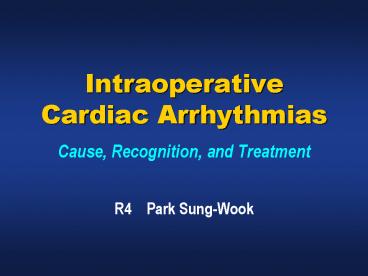Intraoperative Cardiac Arrhythmias Cause, Recognition, and Treatment - PowerPoint PPT Presentation
1 / 22
Title:
Intraoperative Cardiac Arrhythmias Cause, Recognition, and Treatment
Description:
Intraoperative Cardiac Arrhythmias Cause, Recognition, and Treatment R4 Park Sung-Wook Occurrence: 15-85% Rare complication resulting from cardiac arrhythmia in the ... – PowerPoint PPT presentation
Number of Views:1614
Avg rating:3.0/5.0
Title: Intraoperative Cardiac Arrhythmias Cause, Recognition, and Treatment
1
Intraoperative Cardiac ArrhythmiasCause,
Recognition, and Treatment
- R4 Park Sung-Wook
2
- Occurrence 15-85
- Rare complication resulting from cardiac
arrhythmia in the healthy patients - Life-threatening arrhythmia during surgery
- Fewer than 1 of patients
- Almost all have cardiac disease
3
Physiology
- The Action Potential
4
Physiology
- The Action Potential
- Spontaneous diastolic depolarization
- Resting potential not stable in conductive tissue
cell - Slow spontaneous depolarization until the
threshold potential is reached
Slope is controlled by ANS
5
Physiology
- The Action Potential
- Excitability depolariztion to specific stimulus
- Increased excitability
- depolarization to a lesser stimuls or an
exaggerated response to normal stimulus - Refractoriness
- Absolute refractory period phase 0,1,2
- Relative refractory period late phase 3, early 4
- Susceptable to strong stimuli
6
Physiology
- The Conduct System
Control ventricular response to increased supra
ventricular rates
most rapid conduction
7
Physiology
- Electrophysiology of Arrhythmias
- Disturbance of SA nodal rate
- Reentry-associated arrhythmias
- Alternate pathways
- One-way or unidirectional block in one pathway
- An area of slow conduction in the other pathway
8
Diagnostic Criteria
- Supraventricular Arrhythmias
- Rate
- 150 - atrial flutter with 21 AV block
- gt200 - accessory AV pathway
- Regularity
- AF irregular rhythm
- Regular SVT with variable AV block may be
misleading
9
Diagnostic Criteria
- Supraventricular Arrhythmias
- P waves
- Presence of P wave before QRS atrial origin
- No P wave with regular tachycardia AV node or
below - QRS width
- lt0.12 ms supraventricular source
- Wider QRS BBB, aberrant conduction, accessory
path
10
Diagnostic Criteria
- Supraventricular Arrhythmias
- QRS axis
- Severe LAD ventricular origin
- Paroxysmal SVT
- Sinoatrial node reentry normal P
- Atrial tachycardias upright but abnormal
appearing P - Atrioventricular node reentry no P or inverted
- Accessory pathway delta wave
- AF irregular narrow QRS
- A-flutter atrial rate 300 with AV block
11
Diagnostic Criteria
- Ventricular Arrhythmias
- Frequent PVCs, couplets or brief runs of VT
- Healthy persons benign
- Presence of cardiac dis or LV dysfunction
dangerous - Frequent PVCs(gt 6/min) after MI increased
mortality risk
12
Cause and Significance
- Congenital
- Mostly benign
- Accessory pathway tachycardia compromise
hemodynamic stability - Congenital prolonged Q-T interval predispose to
vetricular arrhythmia
13
Cause and Significance
- Acquired
- Vetricular arrhythmia
- IHD., aortic stenosis, dis. associated with LVH
- Atrial fibrillation
- IHD., related to aging, distened aorta (MS, CHF)
- Acquired prolonged Q-T interval
- IHD., electrolyte abnormality, drug side effect
- Progress polymorphic ventricular tachycardia
(torsades de pointes) - CNS dis, ICH, stroke all types of SVT and
vetricular arrhythmia
14
Cause and Significance
- Electrolyte Imbalance
- Low potassium may trigger dangerous vetricular
arrhythmia - Low magnesium produce primarily SVT
- Acute changes in pH
- Anesthesia
- Calcium antagonistic properties
- Halothane sensitize the heart to catecholamines
15
Treatment
- Class I
- Block the fast Na channel decrease the rate of
rapid depolarization - Class IA
- Vagolytic action, decrease contractility,
?-adrenergic blockade - Quinidine, disopyramide, procainamide,
diphenylhydantoin
16
Treatment
- Class I
- Class IB
- Lidocaine
- Used in all types of vetricular arrhythmia
- Except vetricular arrhythmia d/t prolonged Q-T
interval - Toxic effect CNS activation
- Class IC
- Suppressor of phase 0 sodium conductance
- Increased mortality risk
17
Treatment
- Class II
- ß-adrenergic receptor blockers
- Effective in all tachyarrhythmias
- Perioperative management of congenital prolonged
Q-T interval - Toxicity related to bronchoconstriction
18
Treatment
- Class III
- Prolong reploarization
- Increase action potential duration the
effective refractory period - Bretylium
- Facilitation of ventricular defibrillation
- Effective in bupivacaine-induced arrhythmias
19
Treatment
- Class III
- Amiodarone
- Effective all arrhythmia
- Long onset half-life
- Side effect photosensitivity, abnormal skin
pigmentation - Ibutilide
- Effective in converting A-flutter AF
- Side effect hypotension, prolongation of Q-T
interval
20
Treatment
- Class IV
- Calcium channel antagonists
- Supraventricular tachyarrhythmias useful
- Ventricular tachycardias ineffective, severe
cardiac dysfunction - Potentiate the myocardial effects of anesthetics
- Contraindication AF with WPW syndrome
21
Treatment
- Adenosine
- Effective in acutely converting reentrant nodal
SVT accessory pathway SVT - Digoxin
- Perioperatively maintain rate control in
A-flutter AF - Magnesium ion
- Useful in the period around CPB operations
22
Conclusion
- Tx only associated with hemodynamic compromise
and potential to progress to life-threatening
arrhythmias - Must be familiar with only selective drug































